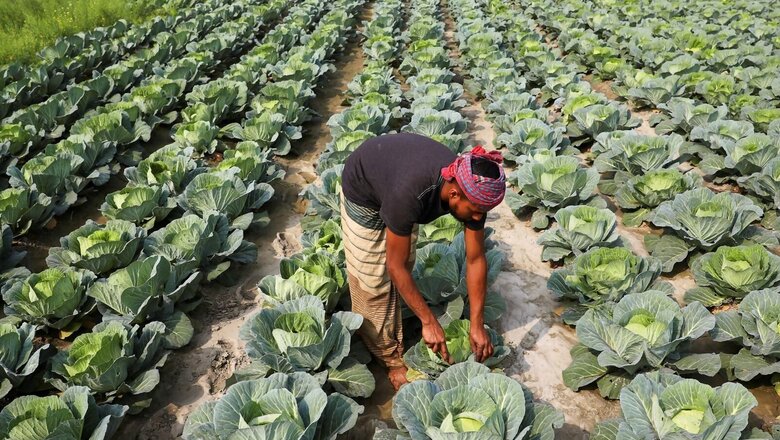
views
There isn’t a mother in the world who has not rebuked, compelled, cajoled, or, in the least, beseeched her offspring into eating vegetables. Considering that green leafy vegetables have been proven time and time again as superior foods, so valuable for brain and body, why is there such a resistance to eat them? I often meet people who come up to me and say, “Oh how I would love to bite into one nice juicy burger”, or “I am so missing a good home made rajma-chawal” or, “I want to eat a good curry and rice or butter chicken and naan”, but I’ve yet to meet someone who has come up to me and said, “Oh I am so dying to eat cabbage”.
Speaking of cabbage, I grew up abhorring this vegetable. Every time cabbage was cooked in our homes, the malodorous odour of putridity encompassed our house, the neighbour’s house, and may I daresay two floors above us and below us. It was like everybody in the building knew there was cabbage cooking at our home. The dish itself would be limp and soggy, with onions albeit generously spiced. Overcooked cabbage is always gross. The more it cooks the more bitter and sulphurous it becomes. And then you are left with a soft quaggy pulp that tastes of a fart. I thought it was revolting. That put me off cabbage for most of my life. The only other encounter with cabbage I would have had is with coleslaw.
My mother used to occasionally make a slaw with shredded cabbage and mayonnaise to stuff chicken sandwiches with. It was nice and crunchy and the mayo disguised most of the cabbage, but cabbage has a distinctive bitter sweet taste, a deep and lasting flavour that lingers, even when you are finished eating. I’d have much preferred lettuce in my slaw.
It was at a shoot for my “food show” that I finally changed my mind. In front of me was a pure vegetarian traditional homemade Gujarati Thali. Khandvi and Ghugra for Farsaan, chutney, salt, a slice of lemon, a slightly sweeter Gujarati-style tur dal, another spicier, masala-laced one chapatti, steamed rice, one potato sabzi, bitter gourd (karela) sabzi, ivy gourd (tendli) sabzi, and the main vegetable was cabbage. The camera rolled, and I started the show, eating and describing the dishes one by one in the most honest and laudatory words.
While speaking and describing the food, I finished the meal, licking my fingers and wiping the plate clean. But I did not touch the cabbage. I was about to wrap up the scene, when my director requested me to finish everything on my plate. Grudgingly, I took a piece of roti and scooped up the cabbage, all the while pretending to the rolling camera, that this was all in a day’s work. I was hoping to swallow the bite whole before I gagged with nausea and disgust. But the bite was too large and I had to start chewing, and suddenly the cabbage crunched in my mouth. As I apprehensively ruminated on the cabbage, I realised it actually tasted quite good. Shredded cabbage had been cooked semi raw, just tossed in a tempering of oil, asafoetida, green chillies and turmeric, with salt. The key is to hardly cook the cabbage and avoid it from becoming a pulpy, smelly mush. It was crunchy, fresh, and quite delicious I have to confess.
So, then what can we do with cabbage that is yummy? This same Gujarati Cabbage Shaak, if stuffed in Atta and rolled out, makes an exceptionally good Patta Gobhi ka Paratha. Actually, it’s a great way to use leftover cabbage.
Of course, there is always a fresh and lively coleslaw, made with a combination of sharply sliced shreds of red and green cabbage, folded into creamy mayonnaise with apple cider vinegar, Dijon mustard, chopped celery, salt and pepper. Goes so well with sandwiches and an accompaniment to burgers and fried fish.
We can also use raw cabbage in a salad, like a Crunchy Mandarin Orange-Chicken Salad, with shredded cabbage, crispy rice noodles, cashews, roasted peanuts, toasted sesame seeds, slices of mandarin oranges, in a dressing of rice wine vinegar, honey, sesame oil, hoisin sauce, soy sauce, with minced ginger and garlic. Quite yummy.
There is also the “handvo” or “kobiche bhanole” (Pathare Prabhu style), both are cakes made with fermented and lentil batter, normally stuffed with lauki but does quite well with cabbage. The cake is first steamed and then baked in an oven. With green chutney, this savoury cake is immense.
All Konkani families make an uncomplicated guileless dish called ‘Upkari’, which is a side dish of stir-fried vegetables, with soaked channa daal, tempered and garnished with coconut. Much like Kerala’s famed Cabbage Thoran. The Kerala-style Thoran and the Konkani Upkari, both don’t use Garam Masala. Shredded cabbage is gently stir-fried or steamed al dente, and red chillies, mustard seeds, maybe turmeric, curry leaves maybe cumin and then garnished with lots of freshly grated coconut.
Even the Veg Manchurian in any Indian Chinese restaurant is made with cabbage pakodas in a Manchurian sauce, or dunked in a gravy of onions, spices and cashew paste make the most delicious veg kofta curry.
That’s how cabbage went from being my worst to my most versatile vegetable.
Kunal Vijayakar is a food writer based in Mumbai. He tweets @kunalvijayakar and can be followed on Instagram @kunalvijayakar. His YouTube channel is called Khaane Mein Kya Hai. The views expressed in this article are those of the author and do not represent the stand of this publication.
Read all the Latest Lifestyle News here


















Comments
0 comment